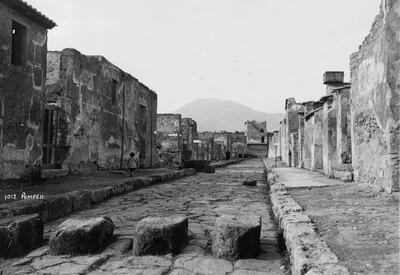They pioneered feats of engineering that we still rely upon today, from bridges and sewers to concrete and roads.
And the Romans also appear to have been early adopters of the art of recycling, according to new findings.
Archeological researchers at Pompeii, the southern Italian city preserved in ash after the eruption of Mount Vesuvius in 79 AD, have found evidence that inhabitants had a system when it came to disposing of rubbish.
Piles of trash outside the city's walls had been preserved as mounds, which were earlier believed to have been created by an earthquake that predated the volcanic eruption.
Professor Allison Emmerson, an American academic who is part of a research team working at the archeological site, this week stated that the mounds were in fact “staging grounds for cycles of use and reuse”.
"We found that part of the city was built out of trash. The piles outside the walls weren't material that's been dumped to get rid of it," said Emmerson, according to The Guardian. "They're outside the walls being collected and sorted to be resold inside the walls."
The mounds, which lined almost an entire external wall on the city's northern side, contained traces of ceramic and plaster, which were likely being conserved as construction materials. The piles were mostly cleared in the mid-20th century, when recycling was far less of a predominant concept, though some examples are still being uncovered.
"The idea has been that all this garbage is the result of that earthquake –rubble that was cleared out of the city and dumped outside of it," said Emmerson. "I thought this was very strange because I see the city really extending outside the walls into the suburbs ... So it didn't make sense to me that they were also being used as landfill."

Scientific analysis has since been used to track the movement of some of the refuse, showing it made its way back from the recycling sites into Pompeii's buildings.
"Garbage dumped in places like latrines or cesspits leaves behind a rich, organic soil. In contrast, waste that accumulated over time on the streets or in mounds outside the city results in a much sandier soil," Emmerson, who worked with fellow archaeologists Steven Ellis and Kevin Dicus, added.
"The difference in soil allows us to see whether the garbage had been generated in the place where it was found, or gathered from elsewhere to be reused and recycled."
Emmerson's research will be published in her forthcoming book, Life and Death in the Roman Suburb, which is due to be released next month.
“The Pompeians lived much closer to their garbage than most of us would find acceptable, not because the city lacked infrastructure and they didn’t bother to manage trash but because their systems of urban management were organised around different principles," she said.
“This point has relevance for the modern garbage crisis. The countries that most effectively manage their waste have applied a version of the ancient model, prioritising commodification rather than simple removal.”
Before it was buried in ash, Pompeii was a bustling city with a population of around 20,000, with the almost perfectly preserved ruins uncovered by a 1748 exploration. It is now a Unesco World Heritage Site that welcomes around 2.5 million visitors a year.


